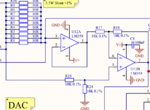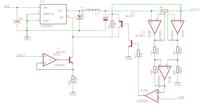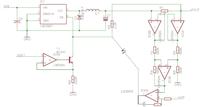aramosfet
Junior Member level 2
- Joined
- Oct 21, 2005
- Messages
- 22
- Helped
- 1
- Reputation
- 2
- Reaction score
- 1
- Trophy points
- 1,283
- Location
- Bangalore,India
- Activity points
- 1,480
Hi All,
I'm trying to measure the current in a LM2576 power supply. I'm using a 1ohm current sense resistor on the output of the regulator. Using an LM358 opamp as differential amplifier, I see the output voltage is stuck at 0.6V when the differential amp resistors are 10K (instead of 18k in schematic). However when the resistor are changed to 100k, I get the correct differential voltage at the output. What is the reason for this?

Thank you
I'm trying to measure the current in a LM2576 power supply. I'm using a 1ohm current sense resistor on the output of the regulator. Using an LM358 opamp as differential amplifier, I see the output voltage is stuck at 0.6V when the differential amp resistors are 10K (instead of 18k in schematic). However when the resistor are changed to 100k, I get the correct differential voltage at the output. What is the reason for this?

Thank you

